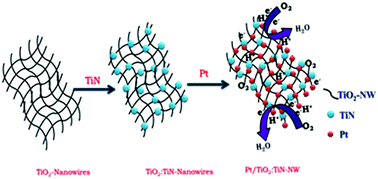Preparation of TiO2:TiN composite nanowires as a support with improved long-term durability in acidic medium for polymer electrolyte fuel cells†
Abstract
A TiO2:TiN composite nanowire-supported catalyst is prepared for oxygen reduction activity in polymer electrolyte fuel cells (PEFCs). The TiO2:TiN composite nanowire supported catalyst shows improved catalytic stability compared to carbon supported Pt. Field emission scanning electron microscopy, transmission electron microscopy, X-ray photoelectron spectroscopy, X-ray diffraction, Brunauer–Emmett–Teller and conductivity measurements have been used to demonstrate morphological effects, oxidation states and crystal structures along with surface area and electrical properties, which play a vital role in enhancing the oxygen reduction reaction. The optimized composition of the TiO2:TiN composite nanowire supported catalyst leads to improved catalyst durability even after 10 000 potential cycles. In PEFCs, the Pt/TiO2:TiN nanowire composite increases corrosion stability and retains 67% of initial cell performance even after 3000 potential cycles between 1 and 1.5 V vs. a dynamic hydrogen electrode as compared to a carbon supported catalyst. After AST, the samples are characterized for the assessment of degradation of fuel cell performance.



 Please wait while we load your content...
Please wait while we load your content...